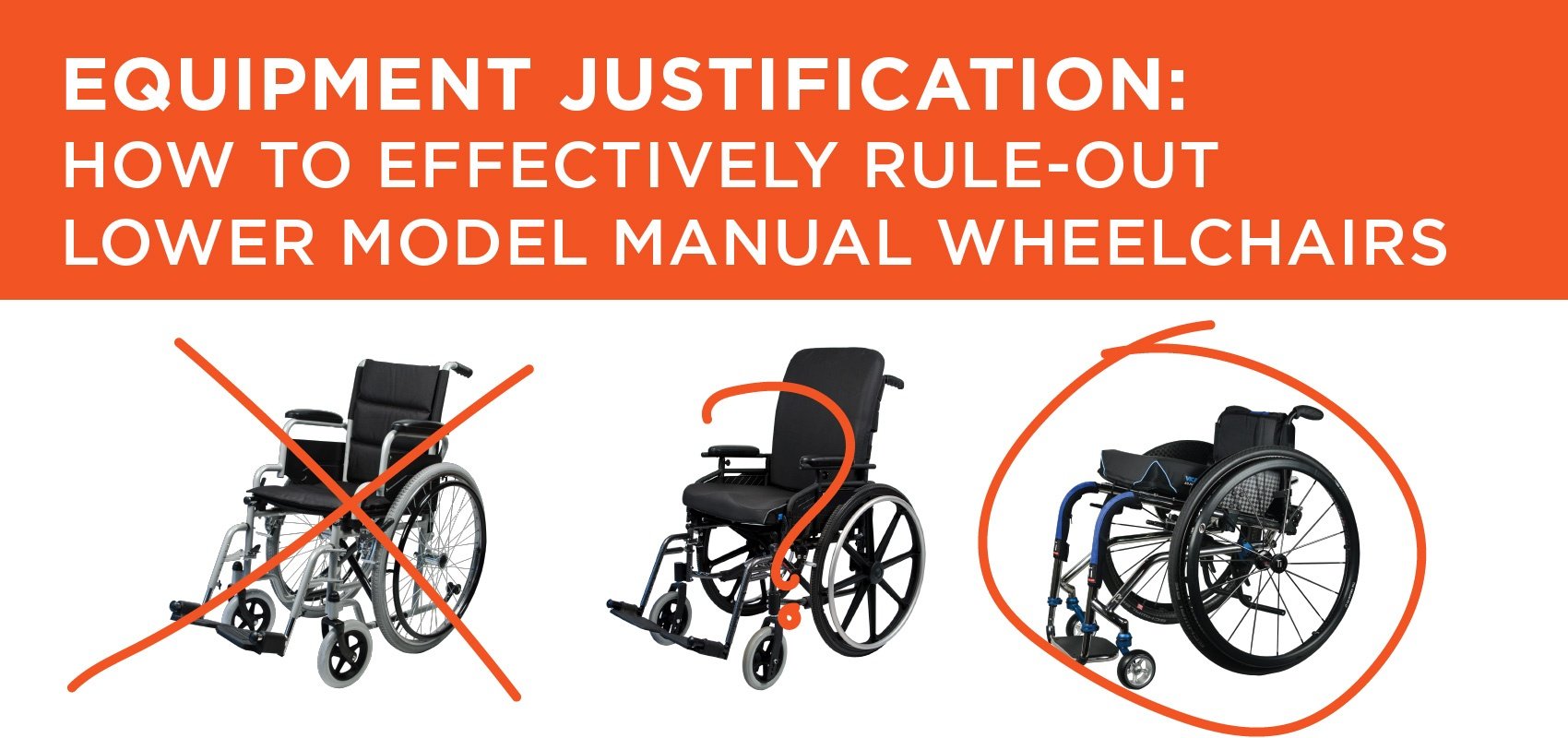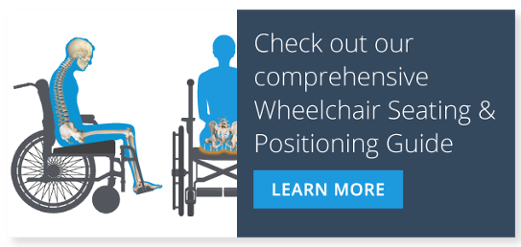Part 12 in our series A to Z Considerations for Seating & Wheeled Mobility: A Quick Reference Clarifying Confusion Around CRT. See Part 1, Part 2, Part 3, Part 4, Part 5, Part 6, Part 7, Part 8, Part 9, Part 10, Part 11, Part 12, Part 13, Part 14, Part 15, Part 16, Part 17, Part 18, and Part 19.
While it would be ideal to actually have your client complete trials in each of the categories of manual wheelchairs discussed in last week’s post, we all know that time is a constraint. Often times, you can rule out many of the lower model manual wheelchairs from the information you gathered during your physical examination.
Questions to Ask Yourself for Manual Wheelchair Justification
- Does the client have the upper body strength (including grip), muscle endurance, coordination, ROM, and balance to proficiently propel the heavier model chairs (K0001-K0004)? Could the client be more independent in a K0005 wheelchair?
- Does the client currently have shoulder pain that could be improved by propelling a lighter weight chair?
- Is the client at risk for shoulder injury and/or pain and joint integrity preservation needs to be a priority? If so, this can help us justify the need for the K0005 wheelchair over the heavier, lower-end models. In addition to being lighter weight, K0005 manual wheelchairs offer axle adjustability so that the wheel can be moved to the optimal position on the base relative to the user’s body for shoulder preservation and efficiency.
|
*TIP: For most wheelchair users, a shoulder injury would be detrimental to their independence. I have seen MANY times where the repetitive strain of propelling a heavy and poor-fitting manual wheelchair resulted in shoulder injury and chronic pain, forcing these clients to turn to power chairs for mobility. Treating the shoulder injury and providing a power chair will cost the payer much more long-term than providing a K0005 manual wheelchair now! |
- Does the client require a specific seat-to-back angle, width or depth, or seat-to-floor height that cannot be achieved in the lower model, less adjustable wheelchairs? If so, consider a K0004 at minimum. Most likely, this client will require a K0005 ultra-lightweight manual chair.
- Is the client an active user who needs to perform wheelies to manage thresholds in the home or curbs in the community? A more adjustable rear axle allows the user to change the center of gravity of the chair for more dynamic performance and optimal energy efficient propulsion.
- Would propelling a heavier model throughout the day take a toll on the body systems and place the client at risk, i.e. an unsafe increase in HR or respiratory rate, or an unsafe drop in O2 saturations? This client will likely require the lightest weight K0005 in order to maintain physiological levels in a safe and functional range.
- Be sure to think about fatigue: perhaps the K0004 can be propelled safely and in a reasonable amount of time right now, but what about at the end of the day for someone who has Multiple Sclerosis, for example? Consider a K0005 for qualifying clients who struggle with fatigue throughout the day in order to conserve energy for MRADLs and other functional tasks.
|
*TIP: Consider the patient’s diagnosis, and ask about fatigue. What times of the day are typically the most challenging for that individual? If possible, schedule your assessment with the client at that time. |
And, sometimes we must actually perform comparison trials to demonstrate to the payer source why the higher end, more-costly model wheelchair is necessary.
Considerations for Manual Wheelchair Comparison Trials
- First, be sure the client is optimally positioned in the wheelchair to be most proficient with manual wheelchair propulsion. Can the client be better “optimally positioned” in a K0005 compared to a K0004, resulting in increased functional independence and improved sitting tolerance?
- Can the client propel the heavier models in a timely manner to get from the bedroom to the bathroom, for example? If not, does the lighter weight model allow the client to accomplish this?
- Consider timing the client propelling a set distance in both a K0004 and a K0005 wheelchair, for example, and compare. Is there a considerable difference? What about when the patient is fatigued?
- Consider trialing various propulsion methods, i.e. BUE propulsion versus BLE foot propulsion? Or, hemi-propulsion?
- Utilize a BORG or modified BORG rate of perceived exertion scale to show the client’s perceived energy cost when performing comparison trials for clients who battle fatigue or have cardiac and/or respiratory issues.
- Assess vitals during/immediately following propulsion in both models you are comparing for clients who have cardiac and/or respiratory issues to objectively demonstrate the increased toll propelling the heavier model takes on the body.
Ok, so now that we have talked about the various types of manual wheelchairs and weighed the benefits and considerations of each, do any of these manual wheelchairs meet your client’s needs? If not, then it is time to start thinking about the possibility of a power wheelchair as your client’s means of mobility. Join me next week as we look at the available types of power chairs on the market and discuss how to assess which of these may be best suited for your client!

Lindsey Sharpe, PT, DPT
Lindsey Sharpe graduated with a BA in Exercise and Sport Science from the University of North Carolina at Chapel Hill in 2007 and with her Doctor of Physical Therapy from Elon University in 2010. Lindsey was a practicing clinician for seven years primarily focusing on neurological conditions and wheelchair seating and positioning.
Lindsey was first introduced to wheelchair seating and positioning during her time on the spinal cord injury team at the University of Virginia's acute rehab hospital where she discovered her interest in and passion for this niche in the therapy world. Lindsey went on to open a brand-new seating clinic with Carolinas Healthcare System in Concord, NC where she advanced her knowledge and skills performing both inpatient and outpatient seating evaluations for clients of all ages having a variety of diagnoses.

